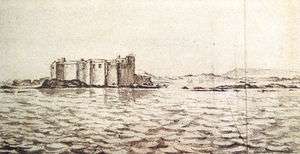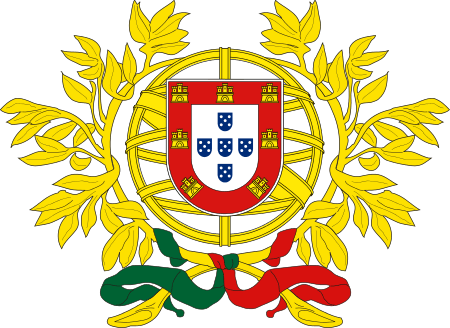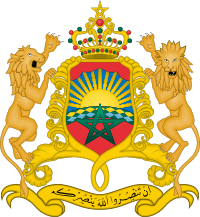Morocco–Portugal relations
Morocco–Portugal relations cover a period of several centuries to the present. After the Reconquista, Portugal would then expand into Africa, starting with the territory nowadays is part of Morocco, by occupying cities and establishing fortified outposts along the Atlantic coast.
 | |
Portugal |
Morocco |
|---|---|
History
- Hispania
- Mauretania Tingitana (42 AD–7th Century)
- Visigothic Kingdom
- African Romance (c. 1st century BC – 14th century)
- Mediterranean Lingua Franca (11th to the 19th centuries)
- Kingdom of the Algarve (1415-1769)
Kingdom of the Algarve (1415–1515)
Portugal started to occupy parts of coastal Morocco under Afonso V of Portugal, Portugal conquered Alcácer Ceguer (1458), Tangier (won and lost several times between 1460 and 1464) and Arzila (1471). This achievements granted the king the nickname of the African.
Portugal and Spain had passed an agreement in 1496 in which they effectively established their zones on influence on the North African coast: Spain could only occupy territory east of Peñon de Velez. This restriction would only end with the dynastic union of the Portuguese and Spanish crowns under Philip II after the 1578 Battle of Ksar El Kebir, when Spain started to take direct actions in Morocco, as in the occupation of Larache.[1]
Altogether, the Portuguese are documented to have seized 5 Moroccan cities and built 6 stand-alone fortresses on the Moroccan Atlantic coast, between the river Loukos in the north and the river of Sous in the south.
The 5 cities were: Alcácer-Ceguer (1458–1550), Tangier (1471–1661), Arzila (1471–1549), Safi (1488–1541) and Azamor (1513–1541).

Of the 6 stand-alone fortresses, four of them only had a short duration: Graciosa (1489), São João da Mamora (1515), Castelo Real of Mogador (1506–10) and Aguz (1520–25). Two of them were to become permanent urban settlements: Santa Cruz do Cabo de Gué (Agadir, founded in 1505-06), and Mazagan founded in 1514-17.[2]
The Portuguese had to abandon most of their settlements between 1541 and 1550 following the offensives of Mohammed ash-Sheikh, particularly the Fall of Agadir in 1541 and the Conquest of Fez in 1550. Nevertheless, they were able to keep a few bases: Ceuta (1415–1668), Tangier (1471–1661) and Mazagan (1502–1769).[2]
The Battle of Ksar El Kebir in 1578 was a landslide event, as the Portuguese king Sebastian of Portugal was killed in the encounter and his army eliminated by Moroccan forces in alliance with the Ottoman Empire.
Moroccan conquest (1631–1769)
Tangier was ceded to England in 1661 in order to encourage England to support Portugal in the Portuguese Restoration War, and Ceuta was finally handed over to Spain in 1668 through the Treaty of Lisbon, which finally recognized the House of Braganza as Portugal's new ruling dynasty and its rule over Portugal's remaining overseas colonies. These events essentially ended Portugal's direct involvement in Morocco, until they abandoned Mazagan under the pressure of Mohammed ben Abdallah in 1769.
Five years later, in 1774, the Governments of Morocco and Portugal concluded a Peace and Friendship Agreement, one of the oldest bilateral agreements of both nations.
Heritage
The Portuguese Fortified City of Mazagan was registered as a UNESCO World Heritage Site in 2004, on the basis of its status as an "outstanding example of the interchange of influences between European and Moroccan cultures" and as an "early example of the realisation of the Renaissance ideals integrated with Portuguese construction technology". According to UNESCO,[3] the most important buildings from the Portuguese period are the cistern, and the Manueline Church of the Assumption.
Built in 1514, this former warehouse (possibly an armory) was converted into a cistern in the sixteenth century. The underground chamber, measuring 34 meters by 34 meters, was constructed with five rows of five stone pillars. The cistern is famous especially for the thin layer of water that covers the floor, and which creates fine and exciting reflections from the little light there is and the spartan shapes of the columns and the roof. Its visual qualities are such that several movies have been filmed within the cavernous space, of which Orson Welles' Othello is the best known internationally.
The design of the Fortress of Mazagan is a response to the development of modern artillery in the Renaissance.[4] The star form of the fortress measures c 250m by 300m. The slightly inclined, massive walls are c 8m high on average, with a thickness of 10m, enclosing a patrolling peripheral walkway 2m wide. At the present time the fortification has four bastions: the Angel Bastion in the east, St Sebastian in the north, St Antoine in the west, and the Holy Ghost Bastion in the south. The fifth, the Governor’s Bastion at the main entrance, is in ruins, having been destroyed by the Portuguese in 1769. Numerous colonial-era Portuguese cannons are still positioned on top of the bastions.
Resident diplomatic missions

Demography
- Language:
- Portuguese language in Morocco - Portuguese language in Africa
- Moroccan Arabic
- Religion
- Christianity in Morocco
- Roman Catholicism in Morocco
- Protestantism in Morocco
- Islam in Portugal
- Christianity in Morocco
Notes
- The last great Muslim empires: history of the Muslim world by Frank Ronald Charles Bagley, Hans Joachim Kissling p.103ff
- City walls: the urban enceinte in global perspective James D. Tracy p.352
- "Portuguese City of Mazagan (El Jadida) - UNESCO World Heritage Centre". Whc.unesco.org. Retrieved 2013-02-10.
- "Portuguese City of Mazagan (El Jadida) - UNESCO Advisory Body Evaluation" (PDF). Retrieved 2013-02-10.



